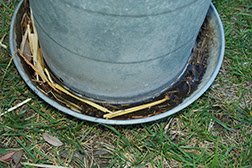Four Steps To Cleaner Water For Your Backyard Chickens
To maintain a healthy and productive flock, poultry owners should
take care to provide a constant source of fresh, clean water. Clean water
allows hens to properly digest their food and regulate their body
temperature. For laying hens, water takes on a third important dimension
because eggs themselves are 74% water by weight.
Water that is contaminated by dirt and debris can have serious
consequences for egg production and the health of chickens. Chickens
whose natural behavior is to scratch the soil looking for seeds and bugs
frequently soil pan-style watering devices that expose the water to the open
air. In the process, they kick dirt and droppings into these open water
pans. Soiled water can negatively impact a flock because chickens tend to
consume less water if it is dirty than if the water were clean, odorless and
tasteless. The specific consequences of dirty water can be
reduced egg production. In more extreme cases, lower water consumption
can result in birds that suffer heat stress and these will stop laying eggs
altogether.
Causes of Contamination
Dirty water can be an indicator of contamination by harmful
bacteria, viruses and fungi. In chicken watering devices, the contamination is
likely to come from three sources:
- An infected bird passes the
disease on to other chickens by way of their dropping either on the soil
or in water.
- Contact with wild birds or other
animals in the chicken’s environment.
- Buildup of biofilm within the watering
device that then provides an environment where harmful bacteria can
flourish.
Biofilm
The last form of contamination is the least intuitive and most
likely the least known by backyard poultry keepers. Biofilm is a buildup
of sticky nutrients created by bacteria that can form on the inside a watering
device.
All water, including municipal tap water, contains some
free-floating bacteria. These bacteria can attach themselves to the walls
of watering device. Once attached they, form an anchor point for other
strains of bacteria that could not adhere to the wall of the waterer on their
own. Over time, more and more types of bacteria attach themselves to the
wall and create a layer of slime or biofilm. This biofilm can then harbor a
variety of bacteria, fungi and viruses that are both harmful to chickens and
people including E. coli and Campylobacter Jejuni that cause food poisoning and
diarrhea.
 |
Photo: Polymicrobic biofilm courtesy of the
U.S. Center for Disease Control (CDC)
|
Four Steps You Can Take To Ensure A Healthy Flock
Here are some steps you can take to keep your water supply clean
and your chickens healthy and laying:
- Keep Poultry Isolated from Wild Birds- Other animals, particularly wild birds, can be a source of infection. The recent appearance of Avian Flu and concern about wild birds as a carrier of the disease underscores the importance of proper safety precautions. It’s best to prevent all contact by keeping your birds in a closed coop and run. If owners let their birds range freely in the garden during the day, then at least minimize the risk of contamination by placing your poultry feeder and waterer in the coop/run to minimize the risk of water and food contamination by wild birds
- Use A Closed System Watering Device – consider moving from a pan-style watering device that exposes water to the open air to a poultry waterer that is closed to the external environment and uses poultry nipples, also called chicken nipples. These closed systems are much less likely to be contaminated by dirt, litter or chicken droppings. These closed-systems are used by commercial poultry producers and have numerous advantages over open, pan-style waterers. The closed system work by delivering water to the flock via closed pipes or water conduits. The water is dispensed to the birds using poultry nipples, one-way valves that deliver a small quantity of water to a bird when it pecks at the stem of the nipple.
 |
| BriteTap Chicken Waterer |
- Clean & Sanitize Your Watering Device Regularly - Clean watering devices on a regular basis to maintain the freshness of the water and to prevent the buildup of biofilm. This includes general cleaning of the device as well as sanitization using hydrogen peroxide, Star-San or other agent to kill any bacteria, viruses and fungi. Traditional pan-style watering devices should be cleaned and sanitized daily because they are highly susceptible to contaminants from the environment. Closed-system watering devices should be cleaned when the flock is turned and periodically as needed. Once per month would be a reasonable general guideline.
BriteTap chicken waterer cleaning video
- Always Provide Clean Water –Municipal tap water will almost certainly be safe for chickens. However, well water may require filtration to remove sediment and heavy concentrations of minerals. A good rule of thumb is that the water should be of sufficient quality that a person would be willing to drink it and as odorless and tasteless as possible. Provide chickens with fresh water every day.
Posting sponsored by ChickenWaterer.com, makers of the BriteTap automatic poultry waterer. The BriteTap waterer shields water from dirt and poop. The water stays clean and there are no messy pans for you to wash out.



Comments
Post a Comment